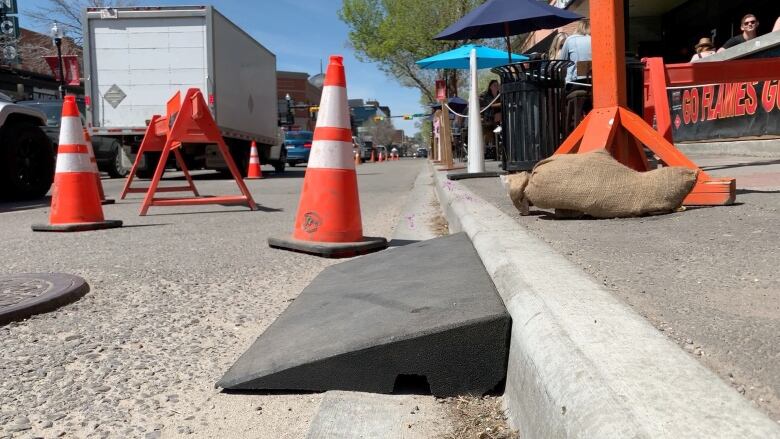Not everyone liking expanded patios and sidewalk lanes on 17th Avenue S.W.
City moved quickly to expand space for restaurants, adjust roads for pedestrians

Calgary has moved quickly to expand restaurant space by easing the patio application process during the pandemic.
During the first stage of Alberta's reopening plan, restaurants can offer dine-in services. But those establishments must limit patrons to 50 per cent of their building's capacity. So, to give those struggling businesses extra seating, patios are now allowed to spill out onto the sidewalk.
The move has been popular with restaurants — in a matter of days, 45 patios have been approved by the city, although only a handful are operational.
So far, the expanded patios are getting mixed reviews.
Beltline resident Ryan Massel said he was shocked when he walked around the corner, headed for a food pickup on 17th Avenue S.W. The patio stretched over several storefronts — and it was difficult to comfortably walk between a lane of traffic, other pedestrians and those sitting down for a bite at Trolley 5.
"Seventeenth is a very busy place. I think we need to consider possible road closure of those areas on 17th that pedestrian traffic is quite heavy in order to keep these restaurants open and people safe," he said. "I mean, one simple pylon is not going to protect me from a moving vehicle."
Massel tweeted about his pedestrian experience and has since seen criticism and support for speaking his mind.
Some came in support of his concerns saying they, too, felt uncomfortable walking on the road, while others said he was needlessly nitpicking, or speaking out of turn.

Trolley 5 owner Ernie Tsu said if people have issues with the pedestrian experience, they need to take it up with the City of Calgary. Being one of the first patios to open, he knew they might catch some flak because, visually, it's a new thing to see after the lengthy lockdown.
"For myself and any of the other restaurants that are going through this process, it's a tough process," Tsu said. "It's not easy."
Tsu says the restaurant worked with the City of Calgary, the fire department and the provincial health authority. Their tables are more than six feet (two metres) apart and laid out in a way that spaces them from the pedestrian walk, along with ensuring his patrons don't wander around within the patio and come too close to other patrons.
Mayor says roads department is working hard
Mayor Naheed Nenshi said Thursday during the city's pandemic update that more changes are coming to 17th Avenue.
"I literally just received a 16-page document about the adaptive roads at 17th Avenue, which did include signs for speed restrictions," Nenshi said. "Our colleagues in roads are working very hard on making sure that we figure out how to manage this new reality."
He said solving a health emergency by creating another one, with increases in traffic incidents, would not be smart. So he's hopeful the city can keep these adaptive sidewalks and patios safe for all.
On Friday, Stephen Avenue Walk will also turn into a patio-way. Daily, after delivery vehicles finish their rounds, the road will close at 11 a.m. to all vehicle traffic so that pedestrians and patios can take over the road.
But Nenshi said that's not an invitation for people to wander down and treat the area like an attraction.
He wants visitors to call ahead and make sure there's space for them at restaurants, and only to visit to support businesses.
Coun. Evan Woolley, whose ward includes much of the Beltline, told CBC News his office is open, and he's there to help with any concerns in his ward.
With the lane closures on 17th Avenue, Woolley said things weren't perfect at first. The city is moving fast to give businesses opportunities. And it's not possible to close entire lanes easily — because some storefronts might want or need their parking.

"We can't have these things snaking on and off the street throughout. So what we're trying to do is get businesses to work together on a block-by-block basis," Woolley said. "To say, 'here's where my business is, I want to have the patio here, and here's where we can have a cluster of loading zones.'"
Then, there's accessibility. In a matter of days, Woolley said, the transportation department was able to fabricate more than 100 ramps to help keep the transition between road and sidewalk smooth and accessible.
"We want to do this safely but we are also working with significant financial pressures," Woolley said. "This needs to be fast and simple, safe and cheap. We are figuring this out on the fly, our roads folks have been doing an incredible job of being nimble."

